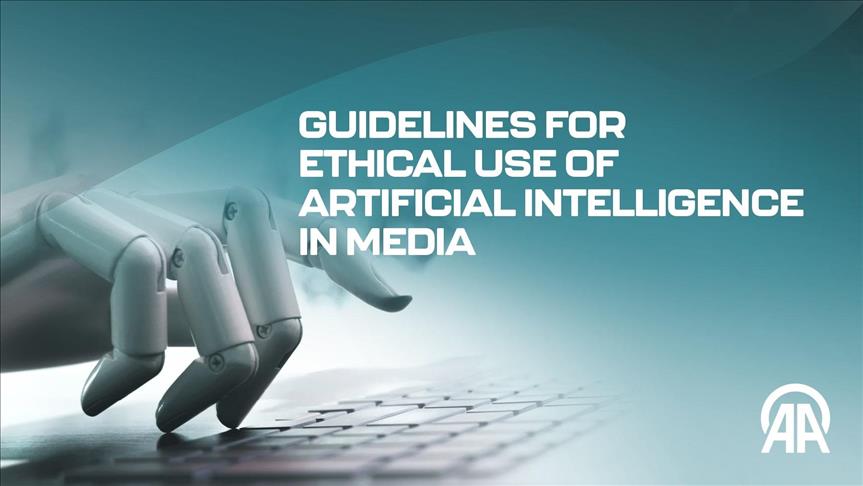ANADOLU AJANSI
THE GUIDE TO ETHICAL USE OF ARTIFICIAL INTELLIGENCE IN MEDIA
The rapid advancement of technology necessitates the use of artificial intelligence (AI) applications in the media sector. AI is transforming the media industry across a broad spectrum, from data processing to content creation, from personalized news streams to automatic language translation. It offers opportunities for news to be processed, analyzed, and presented more quickly and in a way that enhances engagement, while also bringing along ethical, legal, and societal responsibilities. In this context, it is necessary to establish a bridge between the fundamental principles of journalism and the new technological possibilities.
Therefore, as Anadolu Ajans覺, supporting the healthy integration of AI into the media sector, we organized a forum titled 'Managing Artificial Intelligence in Media' at AAtölye. This forum was attended by academics and journalists from Turkey's esteemed universities and media organizations, as well as industry representatives, where the use of AI in media and the ethical principles to be adhered to were discussed. As a result of the forum, the 'The Guide to Ethical Use of Artificial Intelligence in Media' was prepared. This guide aims to contribute to the framework that Anadolu Ajans覺 and other media organizations can follow when utilizing AI technologies.
This guide, which is open to being updated in response to the continuously evolving technological innovations and the changing needs of the media sector, is grounded on Anadolu Ajans覺’s profound journalistic experience and the universal practices of using AI in the media sector. The Guide to Ethical Use of Artificial Intelligence in Media, prepared with the contributions of the forum participants and AA Academy, consists of ten points.
GUIDE TO ETHICAL USE OF ARTIFICIAL INTELLIGENCE IN MEDIA
1. PROTECTION OF JOURNALISTIC PRINCIPLES: Media organizations do not compromise journalistic professional principles in the use of AI. Media organizations strictly adhere to the press ethics that encourage journalists to present news in an accurate, impartial, and ethical manner.
2. USE OF AI ALGORITHMS IN MEDIA: The use of AI algorithms in media effectively occurs in various areas such as personalization of news, content recommendations, language processing, and analysis of sound and images. The use of these technologies brings ethical and legal issues such as data privacy, content manipulation, and impartiality. Therefore, media organizations use algorithms that are consistent with journalistic professional principles and press ethics, ensuring impartiality in the AI applications media organizations use. Media organizations avoid algorithms that exploit humanity's fundamental values and personal weaknesses.
3. FIDELITY TO TRUTH AND VERIFICATION MECHANISM: Media organizations support applications that contribute to the fight against disinformation and fake news. Media organizations remember that AI outputs can be filtered, and may contain false, biased, and discriminatory information. Media organizations are cautious against misleading information and create verification mechanisms. Media organizations avoid any technological applications (like deepfake) that distort the truth. Media organizations allow journalists to use personal initiative for control within the process against the danger of disinformation and manipulation.
4. SOCIAL BENEFIT AND READERS' RIGHTS: The use of AI in the media sector primarily aims to protect social benefit and convey information more effectively. Therefore, AI applications are used by media organizations not to increase circulation, ratings, or views, but to help news reach readers, viewers, and listeners quickly, transparently, and accurately.
5. RESPECT FOR HUMAN DIGNITY AND PRIVACY: Protecting individuals' privacy and personal information is a fundamental human right and must be respected. Therefore, media organizations fully respect data privacy and the right to privacy in the use of personal data, prioritizing consent. Media organizations avoid any AI applications that could harm human dignity. Media organizations license and cite the sources of real human profiles and voices used for AI-based digital twins (digital avatars) in accordance with copyright laws. Media organizations promote fair use by respecting copyright owners and meeting legal requirements.
6. EDITORIAL FRAMEWORK AGAINST BIAS: Potential biases in AI applications can affect the opinions expressed. Therefore, media organizations carefully use these technologies. Media organizations ensure that opinions expressed by AI are supervised and verified by human editors to reduce possible biases.
7. SUSTAINABLE JOURNALISM: AI offers significant opportunities for speeding up processes and automation in the media sector. However, this automation concern should not diminish the value of human creativity. In this context, media organizations regulate the use of AI in creative job fields like news production, cartooning, writing, photojournalism, visual direction, and graphic design, minimizing negative impacts on employment and protecting journalists' rights. Sustainable Journalism promotes a balanced technological integration in the media industry by preserving human capabilities and creativity.
8. PRESERVATION OF HUMAN-PRODUCED INFORMATION AND DIVERSITY: The share of data produced by AI in AI applications is constantly increasing. Media organizations maintain a reasonable level of human-produced original information in AI applications for the sustainability of content richness. Media organizations also pay special attention to the diversity of information and sources. This approach preserves content quality and forms a more robust information foundation by combining AI-produced data and human creativity in a balanced way.
9. LEGAL RESPONSIBILITY, TRANSPARENCY, AND COPYRIGHTS: Media organizations contribute to clearly defining the legal framework of content produced by AI, respecting transparency and copyright issues. In this context, media organizations use a logo to indicate that the content is produced by AI and clearly state AI's contribution and the sources used in the content through footnotes and warnings.
10. LEGAL PROCESS IN THE USE OF AI: The use of AI in media does not yet have a clear legal framework due to the rapid development and changing nature of technology. Until clear universal and national rules and guidelines are established for the use of AI, media organizations follow temporary regulations and ethical rules that have been prepared.
